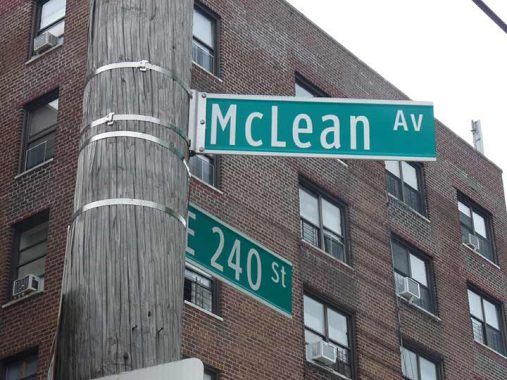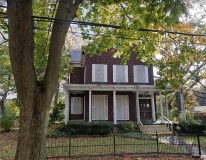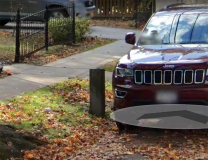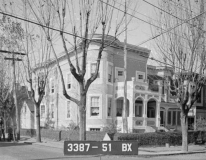
A few Fourths of July ago I took the #4 train to the end of the line at Jerome and Bainbridge Avenues to Woodlawn Cemetery. (A couple of years later, I squeezed off some shots in Woodlawn Cemetery itself, one of NYC’s three large “garden” cemeteries along with Green-Wood in Brooklyn and Evergreens in Brooklyn and Queens; I feel I’ve given Woodlawn short shrift over the years and hope to remedy that presently.) I meandered past Woodlawn and into Woodlawn Heights, the neighborhood north of it, and even past the undefended border into Yonkers for a bit before catching the Metro North back to Manhattan.
To my surprise I got more than 130 photos on this trip and, since the days when I do single pages featuring over 100 photos are done, I’ll split this trip into Parts 1 and 2 and maybe even Part 3.
The IRT Woodlawn line reached the end of the line here in April 1918. Woodlawn Cemetery was incorporated in 1863 by theologian Rev. Absolom Peters (a short street named Peters Place is off East 233rd) with its first interment in 1865. There are plenty of famed interments. The cemetery is the final home of department store founders James Cash Penney and Roland Hussey Macy, jazzmen Duke Ellington and Miles Davis, and Mayor Fiorello LaGuardia, and many other luminaries.
Previously, roll signs in subway cars carried the name “Woodlawn Road” as the destination, and even a few newer signs along the route carried the name. However, Bainbridge Avenue hasn’t been known as Woodlawn Road for quite a few decades.
The story of Van Cortlandt Park begins in 1699, when future NYC mayor Jacobus Van Cortlandt bought a large tract of the Frederick Philipse holdings in the northern Bronx. The land was originally populated by the local Indians as early as 500-600 years ago. In 1748, Jacobus’ son, Frederick, built Van Cortlandt Mansion, which still stands today. New York City obtained the land in 1888 and committed much of it to parkland.
Van Cortlandt Park East, a major 4-lane route, runs along VCP’s northeasternmost section in Woodlawn Heights. To me, the more interesting items in the park can be found at its west end along Broadway (The Putnam RR trail, athletic fields and the mansion itself) but the east end has its moments…
On August 31, 1778, 17 Mohican Indians, led by Chief Abraham Nimham and fighting on the side of the patriots, were massacred after their defeat by Colonel John Graves Simcoe and his Queens Rangers, fighting for the Crown. The Indians are commemorated at Indian Field in Van Cortlandt Park on East 233rd Street east of Jerome Avenue. The Mohicans, all from Stockbridge, Massachusetts, had tracked the British through the Bronx but were finally met by an overwhelming force of British and Hessian troops. This battle, on land owned by the Devoe family, was the only one in the Revolutionary War that occurred completely within what would become Van Cortlandt Park. Chief Nimham was commemorated by tiny Nindham Place in Kingsbridge Heights, but that street has since been demapped.
I had long heard of the Nimham Monument in Woodlawn Heights, but had never been able to find it. Strolling along Van Cortlandt Park East, It suddenly appeared. The Mohicans were buried in Indian Field by the Devoes and their gravesite is marked by a plaque and a cairn, a stone mound used in Scottish burials, at Van Cortlandt Park East and E. 238th Street.
In a city filled with World War I monuments, one of the most distinctive is just across Van Cortlandt Park East in the triangle formed by E. 238th and Oneida Ave, across the street from the Nimham Monument. It consists of a concrete sphere on which sits a sculpture of an American bald eagle, all balanced on a stand containing plaques of Woodlawn Heights soldiers who gave up their lives in the “Great War.” One of them, Private Howard Buse, was killed in the United States, as he was standing guard on the Mill Rift railroad bridge over the Delaware River near Port Jervis and was struck by a train. Famed sculptors the Piccirilli Brothers, whose studio was in Mott Haven, produced the monument; the Piccirilli studio also did the Maine memorial at Columbus Circle, the Patience and Fortitude lions at the NY Public Library and many other well-known monuments.
The City of New York purchased this land in 1924 and assigned it to Parks to create a memorial to residents of Woodlawn Heights who had served in the United States Army or Navy during World War I. On July 4, 1925, the Woodlawn Heights Taxpayers and Community Association dedicated the monument, which is six feet square and thirteen feet high, and holds a sculpture of an eagle atop a sphere. Four bronze plaques bearing the names of the men who served hang on the sides of the monument. Originally, a field gun was at the southern tip of the triangle, but during World War II it was melted down to make new weapons. NYC Parks
Daniel Nimham and his group were not Oneida Indians; it’s thought that the name commemorates the gunboat that Admiral David Farragut (who is buried in Woodlawn Cemetery) commanded at the Battle of New Orleans during the Civil War. The vessel was constructed at the Brooklyn Navy Yard.
As far as Rita Ley…none of my sources identifies her! Comments are open.
A few blocks away at #340 East 234th Street between Katonah and Vireo Avenues you will find this charming carriage house, built in 1878, complete with original wrought iron fence and hitching post, used to secure Dobbin before the auto age. Unfortunately, in this view the windows are boarded up and hopefully it found an owner.
Amazingly there are no landmarked structures in Woodlawn Heights.
There are occasional bluestone sidewalks in Woodlawn Heights that look like blackboards, a mark of an area that has been settled a long time.
A pair of freestanding houses on East 238th between Kepler (named for German astronomer Johannes Kepler (1571-1630) for an unknown reason; perhaps the stargazing was decent in Van Cortlandt Park. It was renamed from Quail Avenue, as many Woodlawn Heights roads were formerly named for birds) and Katonah Avenues.
A pair of corner houses at East 238th and Martha Avenue. Unfortunately much of the original decor has been stripped away from #4331 Martha Avenue, so here’s a view from 1940 when it was still there. The avenue, named for a member of the Varian family that produced a NYC mayor, was formerly Sparrow Avenue.
Woodlawn Heights has a wealth of handsome churches. Emmanuel Presbyterian Reformed Church, 4371 Martha Avenue at East 240th is the former Woodlawn Heights Presbyterian Church and is now affiliated with the Presbyterian Church of Ghana. Details about old churches are sometimes hard to come by, but the cornerstone reads 1913.
A block away at East 241st is St. Barnabas Roman Catholic Church (1911). Coincidentally, one of the Bronx’s biggest hospitals in Fordham is also called St. Barnabas. I have likened some Catholic parishes to small towns as arrayed along East 241st are administrative buildings, the parochial school, girls’ high school and priests’ and nuns’ residences. The parish was founded in 1910 by Reverend Michael A. Reilly. The architects were Starrett & Van Vleck, which also built Saks Fifth Avenue and the American Stock Exchange Building on Trinity Place.
St. Barnabas was a key figure in the early Church as a friend and traveling companion of St. Paul in the first decade AD.
The undefended border of the Bronx and Yonkers cuts directly through the church building on Martha Avenue!

This is the only Department of Transportation McLean Avenue sign, at East 240th Street. For one block, McLean Avenue and East 240th Street share a roadway, split down the center, with different house numbers, McLean Avenue in the 1000s, East 240th in the 500s. A block away, no less than 5 roads come together at the Bronx River Parkway: Bronx River Road and McLean Avenue (Yonkers) and Webster Avenue, Nereid Avenue and East 240th Street (Bronx).

The St. Barnabas Chapel, another building in the vast complex, at McLean Avenue and East 241st Street; it looks too massive to be called a “chapel.”
One of the handsomest war memorials you’ll ever see is in the park across East 241st on McLean Avenue, dedicated to General Joseph Stillwell (1883-1946), who commanded U.S. troops in East Asia and the Indian Subcontinent during WWII. He was born in Florida and graduated from Yonkers High School, hence his remembrance here. He is memorialized in the USA and Asia, including this bust in Changdong, China.
Before ducking back into the Bronx, I wanted to show a few of the fascinating (to me) neon and plastic lettered storefront signs along McLean Avenue.
Next: Along Katonah Avenue into Irishtown
As always, “comment…as you see fit.” I earn a small payment when you click on any ad on the site.
7/16/23





1 comment
Thank you for writing this! Great article. Woodlawn is wonderful.